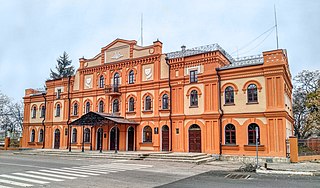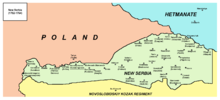
Tarashcha or Tarascha is a city in Bila Tserkva Raion, Kyiv Oblast (region) in central Ukraine. It hosts the administration of Tarashcha urban hromada, one of the hromadas of Ukraine. Population: 9,689.

Chyhyryn is a city in Cherkasy Raion, Cherkasy Oblast, central Ukraine. It is located on Tiasmyn river not far where it enters Dnieper.

Oleksandriia is a city in Kirovohrad Oblast, central Ukraine. It serves as the administrative center of Oleksandriia Raion. It also hosts the administration of Oleksandriia urban hromada, one of the hromadas of Ukraine. Oleksandriia is located within the Kryvyi Rih metropolitan area.

Oster is a city in Chernihiv Raion, Chernihiv Oblast, Ukraine. It is located where the Oster River flows into the Desna. Oster hosts the administration of Oster urban hromada, one of the hromadas of Ukraine. Its population is 5,564.

Hadiach, sometimes spelled Hadyach, Gadyach, Gadiach, Haditch, or Hadziacz, is a city in Myrhorod Raion, Poltava Oblast (province) in the central-east part of Ukraine. It hosts the administration of Hadiach urban hromada, one of the hromadas of Ukraine. Hadiach is located on the Psel River. Population: 22,851.

Haivoron is a city in Holovanivsk Raion, Kirovohrad Oblast, Ukraine. It hosts the administration of Haivoron urban hromada, one of the hromadas of Ukraine. Population: 14,010.

Pomichna is a city in Novoukrainka Raion, Kirovohrad Oblast, Ukraine. It hosts the administration of Pomichna urban hromada, one of the hromadas of Ukraine. Population: 8,608.

Bila Tserkva Raion is a raion (district) in Kyiv Oblast of Ukraine. Its administrative center is the city of Bila Tserkva. Population: 431,172 .

Haivoron Raion was a raion (district) of Kirovohrad Oblast in central Ukraine. The administrative center of the raion was the town of Haivoron. The raion was abolished on 18 July 2020 as part of the administrative reform of Ukraine, which reduced the number of raions of Kirovohrad Oblast to four. The area of Haivoron Raion was merged into Holovanivsk Raion. The last estimate of the raion population was 36,171.

Holovanivsk Raion is a raion (district) of Kirovohrad Oblast in central Ukraine. The administrative center of the raion is the urban-type settlement of Holovanivsk. Its population is 118,803.

Novoarkhanhelsk Raion was a raion (district) of Kirovohrad Oblast in central Ukraine. The administrative center of the raion was the urban-type settlement of Novoarkhanhelsk. The raion was abolished on 18 July 2020 as part of the administrative reform of Ukraine, which reduced the number of raions of Kirovohrad Oblast to four. The area of Novoarkhanhelsk Raion was merged into Holovanivsk Raion. The last estimate of the raion population was 23,524.

Vilshanka Raion was a raion (district) of Kirovohrad Oblast in central Ukraine. The administrative center of the raion was the urban-type settlement of Vilshanka. The raion was abolished on 18 July 2020 as part of the administrative reform of Ukraine, which reduced the number of raions of Kirovohrad Oblast to four. The area of Vilshanka Raion was merged into Holovanivsk Raion. The last estimate of the raion population was 12,003.
Lysets is a rural settlement in Ivano-Frankivsk Raion, Ivano-Frankivsk Oblast, Ukraine, located 10 kilometres (6.2 mi) from the administrative center of the oblast, Ivano-Frankivsk. It hosts the administration of Lysets settlement hromada, one of the hromadas of Ukraine. Population: 2,910.

Antoniny, formerly known as Holodky (Голодьки) and Antonyny (Антонини), is a rural settlement in Khmelnytskyi Raion, Khmelnytskyi Oblast, western Ukraine. It hosts the administration of Antoniny settlement hromada, one of the hromadas of Ukraine. The settlement's population was 2,655 as of the 2001 Ukrainian Census and 2,111.
Narkevychi is a rural settlement in Khmelnytskyi Raion, Khmelnytskyi Oblast, western Ukraine. It hosts the administration of Narkevychi settlement hromada, one of the hromadas of Ukraine. The settlement's population was 1,708 as of the 2001 Ukrainian Census. Current population: 1,457.

Nebelivka is a village in Holovanivsk Raion, Kirovohrad Oblast, Ukraine. It belongs to Pidvysoke rural hromada, one of the hromadas of Ukraine. As of 2001, it had a population of 713.
Petrove is a rural settlement in Oleksandriia Raion of Kirovohrad Oblast (region) of Ukraine. It hosts the administration of Petrove settlement hromada, one of the hromadas of Ukraine. Population: 6,914 .
Vilshanka is a rural settlement in Holovanivsk Raion of Kirovohrad Oblast in Ukraine. It is located on the left bank of the Syniukha, a left tributary of the Southern Bug. Vilshanka hosts the administration of Vilshanka settlement hromada, one of the hromadas of Ukraine. Population: 4,526.
Salkove is a rural settlement in Holovanivsk Raion of Kirovohrad Oblast in Ukraine. It is located on the left bank of the Southern Bug. Salkove belongs to Zavallia settlement hromada, one of the hromadas of Ukraine. Population: 1,555.
Zavallia is a rural settlement in Holovanivsk Raion of Kirovohrad Oblast in Ukraine. It is located on the left bank of the Southern Bug. Zavallia hosts the administration of Zavallia settlement hromada, one of the hromadas of Ukraine. Population: 4,433.



















